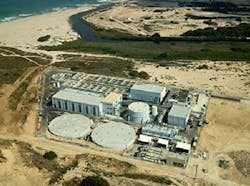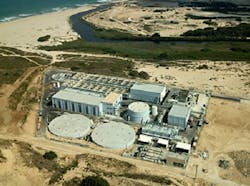Desalination and water reuse markets continue to recover
LONDON, England - The international desalination market has shown a third year of continued growth following a slowdown in the mid-2000s.
Data from the International Desalination Association (IDA) 2016 – 2017 IDA Desalination Yearbook indicates that desalination totals were up 14% in mid-2015 over the same time period in 2014, showing an increase in activity after a 13-year low in the desalination market.
The period June 2015 to June 2016 saw an increase of 3.7 million cubic meters per day (m3/d) of desalination capacity added globally, compared to 3.2 million m3/d the previous year.
Globally, the cumulative installed capacity of the 18,983 desalination plants considered to be online is 88.6 million m3/day.
This number includes plants under construction that are expected to be completed by end of 2016. The cumulative global contracted capacity as of June 30, 2016 reached 95.6 million m³/day.
Much of this added capacity came from a slew of awards for large-scale seawater projects, particularly in the Gulf region, as 2016 marked the third yearly increase in seawater capacity added, from 1 million m³/d additional capacity in 2014 to 1.6 million m³/day so far in 2016, surpassing 2015’s total by 200,000 m³/day.
The increase in large-scale projects over the past three years also swung utility users back into the majority again, with nearly 60% of capacity awarded to utility users in 2015.
Overall, the global cumulative installed and online capacity equated to 73% membrane-based desalination plants and 27% thermal. In contracted capacity for 2015-June 2016, 93% was membrane and 7% thermal.
Within the thermal plants, 73% were multi-stage flash (MSF) and 27% multi-effect distillation (MED).
Meanwhile, the brackish desalination market held steady in 2015 while other feed water streams are near 2014 levels in 2016 after a strong showing in 2015.
Interestingly, a resurgence of interest in reuse projects is occurring not only in North America but also in India and China, as the latter two markets experience continued industrialization and environmental control.
“The reuse market is set to grow significantly as both industry and municipalities are beginning to fully grasp the benefits of water reuse projects, either for cost savings and/or environmental benefits and commitments,” said Patricia A. Burke, secretary general of the International Desalination Association.
The 2016 – 2017 IDA Desalination Yearbook also shows that the largest gains in desalination capacity this year were in the Middle East and North Africa, driven by several new large projects and increased activity in Egypt and Oman. However, traditionally desalination-heavy Saudi Arabia saw mostly small projects this year as it deals with the maze of its national water policy and future desalination strategy as well as the effect of stubbornly low commodities prices.
Commodity prices have also affected growth in Latin America, particularly in mining-heavy countries such as Chile and Peru, but competition for resources and a predicted recovery in prices should spur activity in the region in the medium-term. New forays into desalination by the Philippines and Nigeria also demonstrate new opportunities in an expanding global market.
Private sector funding has also improved, surpassing 30% of total awarded capacity in 2015 for the first time in six years, and can also be attributed to the slew of new large-scale projects in the past year.
###
Read more
Global water reuse/recycling efforts recognised in IDA awards

